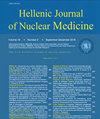Development of hypothyroidism over 13 years of follow-up of patients with hyperthyroidism after radioiodine therapy.
IF 0.9
4区 医学
Q4 RADIOLOGY, NUCLEAR MEDICINE & MEDICAL IMAGING
引用次数: 0
Abstract
OBJECTIVE To analyze the incidence and associated factors of hypothyroidism after radioiodine treatment for hyperthyroidism during a 13-year follow-up period. SUBJECTS AND METHODS This was a retrospective study of consecutive patients with hyperthyroidism who were treated using a single dose of radioactive iodine (RAI) with a calculated dose regimen from 07/2005 to 12/2012. Univariate and multivariate Cox regression models were used to examine the factors that are associated with the occurrence of hypothyroidism after RAI therapy. Kaplan-Meier analysis was used for confirming associations between these models. RESULTS A total of 182 patients were included during a 7.5-year median follow-up (range: 6-13 years). They were 36.4±11.1 years. The mean radioactive iodine dosage was 308.2±104.3 (range: 129.5-740.0) MBq. The rates of euthyroidism, early hypothyroidism, improvement, and ineffective treatment at 6 months were 48.4%, 37.9%, 8.8%, and 4.9%, respectively. The cumulative incidence of hypothyroidism in all patients with hyperthyroidism was 45.6% at 1 year, 48.9% at 5 years, and 52.3% at 10 years. Thyroid weight >46g (HR=0.643, 95%CI: 0.422-0.981, P=0.040) and a course of disease of 0.5-3 years (HR=0.592, 95%CI: 0.358-0.981, P=0.042) were identified as independent factors associated with an increased risk of hypothyroidism after radioactive iodine therapy. CONCLUSION Radioactive iodine treatment with a calculated dose has a high cure rate for hyperthyroidism and has a low annual increase of hypothyroidism. Hypothyroidism after radioactive iodine treatment is more likely to occur in patients with small thyroid and a short disease course.放射性碘治疗后甲状腺机能亢进患者13年随访中甲状腺功能减退的进展。
目的分析放射性碘治疗甲亢患者13年随访期间甲状腺功能减退的发生率及相关因素。研究对象和方法:本研究是一项回顾性研究,从2005年7月至2012年12月,连续接受单剂量放射性碘(RAI)治疗的甲状腺功能亢进患者。采用单因素和多因素Cox回归模型研究与RAI治疗后甲状腺功能减退发生相关的因素。Kaplan-Meier分析用于确认这些模型之间的关联。结果共纳入182例患者,中位随访时间为7.5年(6-13年)。平均年龄36.4±11.1岁。放射性碘的平均剂量为308.2±104.3(范围:129.5 ~ 740.0)MBq。6个月时甲状腺功能亢进率为48.4%,早期甲状腺功能减退率为37.9%,改善率为8.8%,治疗无效率为4.9%。所有甲亢患者甲状腺功能减退的累积发病率在1年时为45.6%,5年时为48.9%,10年时为52.3%。甲状腺体重bb0 46g (HR=0.643, 95%CI: 0.422-0.981, P=0.040)和病程0.5-3年(HR=0.592, 95%CI: 0.358-0.981, P=0.042)是放射性碘治疗后甲状腺功能减退风险增加的独立因素。结论计算剂量放射性碘治疗甲亢治愈率高,甲减年增率低。放射性碘治疗后甲状腺功能减退更容易发生在甲状腺小、病程短的患者身上。
本文章由计算机程序翻译,如有差异,请以英文原文为准。
求助全文
约1分钟内获得全文
求助全文
来源期刊
CiteScore
1.40
自引率
6.70%
发文量
34
审稿时长
>12 weeks
期刊介绍:
The Hellenic Journal of Nuclear Medicine published by the Hellenic Society of
Nuclear Medicine in Thessaloniki, aims to contribute to research, to education and
cover the scientific and professional interests of physicians, in the field of nuclear
medicine and in medicine in general. The journal may publish papers of nuclear
medicine and also papers that refer to related subjects as dosimetry, computer science,
targeting of gene expression, radioimmunoassay, radiation protection, biology, cell
trafficking, related historical brief reviews and other related subjects. Original papers
are preferred. The journal may after special agreement publish supplements covering
important subjects, dully reviewed and subscripted separately.

 求助内容:
求助内容: 应助结果提醒方式:
应助结果提醒方式:


